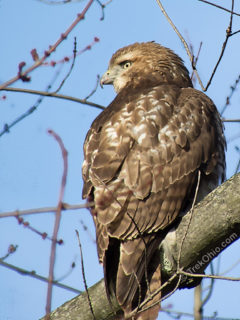 On New Year's Day we went on our first hike of the year: a birding hike at Blacklick Woods Metro Park. About twenty people joined a park naturalist, Colleen, for the two-mile hike. If you're beginning birders like us, it's really helpful to join up with a group such as this. On a number of occasions the naturalist or other members of the group pointed out birds that I'm sure I would have missed otherwise. We also learned some of the places that certain species of bird like to frequent, so when we Read more ➜
On New Year's Day we went on our first hike of the year: a birding hike at Blacklick Woods Metro Park. About twenty people joined a park naturalist, Colleen, for the two-mile hike. If you're beginning birders like us, it's really helpful to join up with a group such as this. On a number of occasions the naturalist or other members of the group pointed out birds that I'm sure I would have missed otherwise. We also learned some of the places that certain species of bird like to frequent, so when we Read more ➜ Birding at Blacklick Woods on New Year’s Day
 On New Year's Day we went on our first hike of the year: a birding hike at Blacklick Woods Metro Park. About twenty people joined a park naturalist, Colleen, for the two-mile hike. If you're beginning birders like us, it's really helpful to join up with a group such as this. On a number of occasions the naturalist or other members of the group pointed out birds that I'm sure I would have missed otherwise. We also learned some of the places that certain species of bird like to frequent, so when we Read more ➜
On New Year's Day we went on our first hike of the year: a birding hike at Blacklick Woods Metro Park. About twenty people joined a park naturalist, Colleen, for the two-mile hike. If you're beginning birders like us, it's really helpful to join up with a group such as this. On a number of occasions the naturalist or other members of the group pointed out birds that I'm sure I would have missed otherwise. We also learned some of the places that certain species of bird like to frequent, so when we Read more ➜ 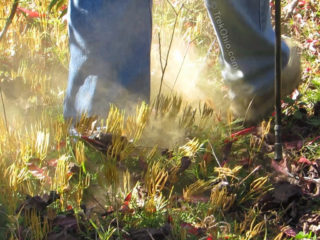 During a recent hike to Trimmer Arch, I was startled when my peripheral vision caught sight of "smoke" rising up around my ankles. When I stopped and looked down, I realized that it wasn't smoke, but instead clouds of spores.
These ripe spores were being released by ground cedar. The spores produced by it and other members of its family have an exceptionally high fat content. People have utilized these spores industrially over the years, and in this capacity they are referred to collectively
During a recent hike to Trimmer Arch, I was startled when my peripheral vision caught sight of "smoke" rising up around my ankles. When I stopped and looked down, I realized that it wasn't smoke, but instead clouds of spores.
These ripe spores were being released by ground cedar. The spores produced by it and other members of its family have an exceptionally high fat content. People have utilized these spores industrially over the years, and in this capacity they are referred to collectively 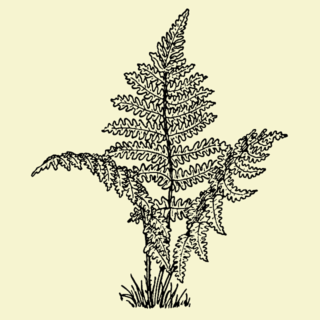 For some time I had been wanting to learn more about ferns, so I took advantage of a workshop on fern identification being held at the Wahkeena Nature Preserve in Fairfield County, Ohio. Wahkeena is a great place to learn about ferns since 29 species of fern grow there (Wahkeena's official blog publishes a list of their local fern species). Naturalist Tom Shisler led the workshop which is called Focus on Ferns. In this post I'm going to introduce you to a number of common ferns found in Ohio by
For some time I had been wanting to learn more about ferns, so I took advantage of a workshop on fern identification being held at the Wahkeena Nature Preserve in Fairfield County, Ohio. Wahkeena is a great place to learn about ferns since 29 species of fern grow there (Wahkeena's official blog publishes a list of their local fern species). Naturalist Tom Shisler led the workshop which is called Focus on Ferns. In this post I'm going to introduce you to a number of common ferns found in Ohio by 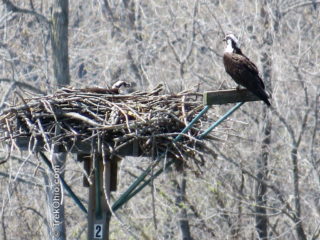 Once again, a mated pair of osprey is nesting on one of the platforms at the northern end of Hoover reservoir. We observed one osprey on the perch above the nesting platform. The second osprey was in the nest doing something with the eggs or perhaps newly hatched youngsters. Periodically we would see its head or tail stick up above the nest as it moved around. But because the sides of the nests are so tall, most of the time we couldn't see it.
Photographing the osprey was a challenge
Once again, a mated pair of osprey is nesting on one of the platforms at the northern end of Hoover reservoir. We observed one osprey on the perch above the nesting platform. The second osprey was in the nest doing something with the eggs or perhaps newly hatched youngsters. Periodically we would see its head or tail stick up above the nest as it moved around. But because the sides of the nests are so tall, most of the time we couldn't see it.
Photographing the osprey was a challenge 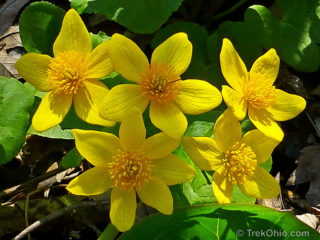 Before the trees leaf out in the spring, tiny wildflowers emerge taking advantage of the extra sunlight that reaches the forest floor. This past April we searched for wildflowers at four Ohio State Nature Preserves. Two were in Champaign County (Cedar Bog and Davey Woods) and two were in Fairfield County (Wahkeena and Shallenberger). Below are some of the flowers that we saw.
Cedar Bog
The marsh marigold pictured above are beautiful, yellow flowers, but the picture does not convey
Before the trees leaf out in the spring, tiny wildflowers emerge taking advantage of the extra sunlight that reaches the forest floor. This past April we searched for wildflowers at four Ohio State Nature Preserves. Two were in Champaign County (Cedar Bog and Davey Woods) and two were in Fairfield County (Wahkeena and Shallenberger). Below are some of the flowers that we saw.
Cedar Bog
The marsh marigold pictured above are beautiful, yellow flowers, but the picture does not convey 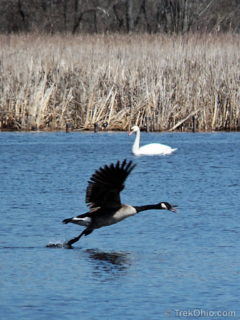 The same day we visited Clifton Gorge, we drove 40 minutes south to Spring Valley Wildlife Area. It was a gorgeous sunny, but cool day. A perfect day for a walk around the lake and marsh at Spring Valley.
Spring Valley is an 842 acre state wildlife area on the border of Greene and Warren counties. It features an archery range, as well as shotgun, rifle and pistol ranges. It also includes a 150 acre lake and marsh with a 2.5 mile trail around it, and an extensive boardwalk leading
The same day we visited Clifton Gorge, we drove 40 minutes south to Spring Valley Wildlife Area. It was a gorgeous sunny, but cool day. A perfect day for a walk around the lake and marsh at Spring Valley.
Spring Valley is an 842 acre state wildlife area on the border of Greene and Warren counties. It features an archery range, as well as shotgun, rifle and pistol ranges. It also includes a 150 acre lake and marsh with a 2.5 mile trail around it, and an extensive boardwalk leading 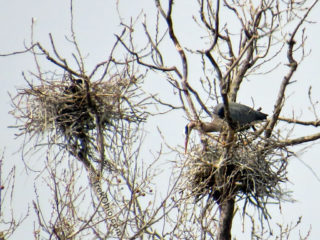 Last month in Delaware County, naturalist Kim Banks held a special program on great blue herons. Mated pairs of these herons nest very close to one another in what's called a heronry. Participants then drove from Deer Haven Preserve (one of the county parks) to a nearby Liberty Township preserve known as Smith Preserve at Olentangy Falls. It turns out that there is a sizable heronry there. I returned just last week to see how things were developing.
Smith Preserve offers no trails
Last month in Delaware County, naturalist Kim Banks held a special program on great blue herons. Mated pairs of these herons nest very close to one another in what's called a heronry. Participants then drove from Deer Haven Preserve (one of the county parks) to a nearby Liberty Township preserve known as Smith Preserve at Olentangy Falls. It turns out that there is a sizable heronry there. I returned just last week to see how things were developing.
Smith Preserve offers no trails 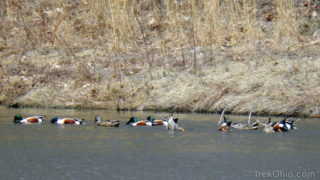 Duck species are typically divided into dabblers and divers. Dabblers feed on vegetation and invertebrates that are on or near the surface of the water, while divers swim beneath the water in pursuit of invertebrates and fish.
Photo courtesy of Joanna Lee Osborn, license: CC BY 2.0
This male mallard is dabbling bottoms up.
Dabblers also differ from divers with respect to the location of their legs. A dabbler's legs are positioned in the middle of the duck's underside.
Duck species are typically divided into dabblers and divers. Dabblers feed on vegetation and invertebrates that are on or near the surface of the water, while divers swim beneath the water in pursuit of invertebrates and fish.
Photo courtesy of Joanna Lee Osborn, license: CC BY 2.0
This male mallard is dabbling bottoms up.
Dabblers also differ from divers with respect to the location of their legs. A dabbler's legs are positioned in the middle of the duck's underside. 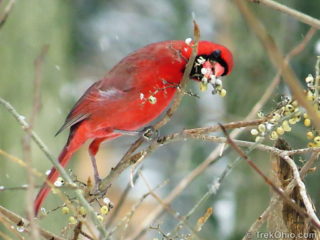 In an earlier post on poison ivy, we noted that birds are untroubled by poison ivy. In fact the vine's berries are an important food source during the cold, winter months. According to an article by Penn State University (linked at the end of this post), over 60 species of bird have been observed eating poison ivy berries. While out for a walk I recently noticed a northern cardinal feasting on them.
I'm seeing a lot of poison ivy berries this time of year. You might not recognize
In an earlier post on poison ivy, we noted that birds are untroubled by poison ivy. In fact the vine's berries are an important food source during the cold, winter months. According to an article by Penn State University (linked at the end of this post), over 60 species of bird have been observed eating poison ivy berries. While out for a walk I recently noticed a northern cardinal feasting on them.
I'm seeing a lot of poison ivy berries this time of year. You might not recognize 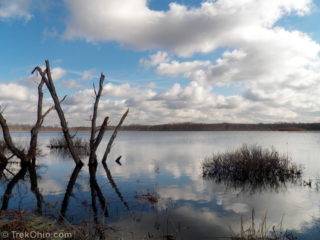 Killbuck Marsh is a 5,761-acre wildlife area in Wayne and Holmes counties located near the town of Wooster. It is the largest marsh outside of the northern Lake Erie region; over half its acreage is wetland.
The Wildlife Area
A section of the wildlife area is designated as a wildlife refuge and is off-limits to visitors. The remainder is available for hunters (during hunting season) and fishermen. There are a couple of short trails and numerous scattered parking areas and pull-offs
Killbuck Marsh is a 5,761-acre wildlife area in Wayne and Holmes counties located near the town of Wooster. It is the largest marsh outside of the northern Lake Erie region; over half its acreage is wetland.
The Wildlife Area
A section of the wildlife area is designated as a wildlife refuge and is off-limits to visitors. The remainder is available for hunters (during hunting season) and fishermen. There are a couple of short trails and numerous scattered parking areas and pull-offs